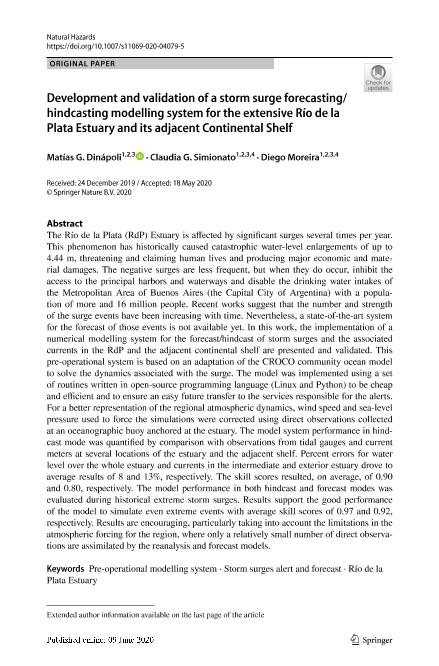Mostrar el registro sencillo del ítem
dc.contributor.author
Dinapoli, Matias

dc.contributor.author
Simionato, Claudia Gloria

dc.contributor.author
Moreira, Diego

dc.date.available
2021-10-18T16:45:28Z
dc.date.issued
2020-06
dc.identifier.citation
Dinapoli, Matias; Simionato, Claudia Gloria; Moreira, Diego; Development and validation of a storm surge forecasting/hindcasting modelling system for the extensive Río de la Plata Estuary and its adjacent Continental Shelf; Springer; Natural Hazards; 103; 2; 6-2020; 2231-2259
dc.identifier.issn
0921-030X
dc.identifier.uri
http://hdl.handle.net/11336/144108
dc.description.abstract
The Río de la Plata (RdP) Estuary is affected by significant surges several times per year. This phenomenon has historically caused catastrophic water-level enlargements of up to 4.44 m, threatening and claiming human lives and producing major economic and material damages. The negative surges are less frequent, but when they do occur, inhibit the access to the principal harbors and waterways and disable the drinking water intakes of the Metropolitan Area of Buenos Aires (the Capital City of Argentina) with a population of more and 16 million people. Recent works suggest that the number and strength of the surge events have been increasing with time. Nevertheless, a state-of-the-art system for the forecast of those events is not available yet. In this work, the implementation of a numerical modelling system for the forecast/hindcast of storm surges and the associated currents in the RdP and the adjacent continental shelf are presented and validated. This pre-operational system is based on an adaptation of the CROCO community ocean model to solve the dynamics associated with the surge. The model was implemented using a set of routines written in open-source programming language (Linux and Python) to be cheap and efficient and to ensure an easy future transfer to the services responsible for the alerts. For a better representation of the regional atmospheric dynamics, wind speed and sea-level pressure used to force the simulations were corrected using direct observations collected at an oceanographic buoy anchored at the estuary. The model system performance in hindcast mode was quantified by comparison with observations from tidal gauges and current meters at several locations of the estuary and the adjacent shelf. Percent errors for water level over the whole estuary and currents in the intermediate and exterior estuary drove to average results of 8 and 13%, respectively. The skill scores resulted, on average, of 0.90 and 0.80, respectively. The model performance in both hindcast and forecast modes was evaluated during historical extreme storm surges. Results support the good performance of the model to simulate even extreme events with average skill scores of 0.97 and 0.92, respectively. Results are encouraging, particularly taking into account the limitations in the atmospheric forcing for the region, where only a relatively small number of direct observations are assimilated by the reanalysis and forecast models.
dc.format
application/pdf
dc.language.iso
eng
dc.publisher
Springer

dc.rights
info:eu-repo/semantics/openAccess
dc.rights.uri
https://creativecommons.org/licenses/by-nc-sa/2.5/ar/
dc.subject
PRE-OPERATIONAL MODELLING SYSTEM
dc.subject
RÍO DE LA PLATA ESTUARY
dc.subject
STORM SURGES ALERT AND FORECAST
dc.subject.classification
Oceanografía, Hidrología, Recursos Hídricos

dc.subject.classification
Ciencias de la Tierra y relacionadas con el Medio Ambiente

dc.subject.classification
CIENCIAS NATURALES Y EXACTAS

dc.title
Development and validation of a storm surge forecasting/hindcasting modelling system for the extensive Río de la Plata Estuary and its adjacent Continental Shelf
dc.type
info:eu-repo/semantics/article
dc.type
info:ar-repo/semantics/artículo
dc.type
info:eu-repo/semantics/publishedVersion
dc.date.updated
2021-09-07T18:13:33Z
dc.journal.volume
103
dc.journal.number
2
dc.journal.pagination
2231-2259
dc.journal.pais
Alemania

dc.description.fil
Fil: Dinapoli, Matias. Consejo Nacional de Investigaciones Científicas y Técnicas. Oficina de Coordinación Administrativa Ciudad Universitaria. Centro de Investigaciones del Mar y la Atmósfera. Universidad de Buenos Aires. Facultad de Ciencias Exactas y Naturales. Centro de Investigaciones del Mar y la Atmósfera; Argentina. Instituto Franco-argentino sobre Estudios del Clima y sus Impactos; Argentina
dc.description.fil
Fil: Simionato, Claudia Gloria. Consejo Nacional de Investigaciones Científicas y Técnicas. Oficina de Coordinación Administrativa Ciudad Universitaria. Centro de Investigaciones del Mar y la Atmósfera. Universidad de Buenos Aires. Facultad de Ciencias Exactas y Naturales. Centro de Investigaciones del Mar y la Atmósfera; Argentina. Instituto Franco-argentino sobre Estudios del Clima y sus Impactos; Argentina
dc.description.fil
Fil: Moreira, Diego. Consejo Nacional de Investigaciones Científicas y Técnicas. Oficina de Coordinación Administrativa Ciudad Universitaria. Centro de Investigaciones del Mar y la Atmósfera. Universidad de Buenos Aires. Facultad de Ciencias Exactas y Naturales. Centro de Investigaciones del Mar y la Atmósfera; Argentina. Instituto Franco-argentino sobre Estudios del Clima y sus Impactos; Argentina
dc.journal.title
Natural Hazards

dc.relation.alternativeid
info:eu-repo/semantics/altIdentifier/url/http://link.springer.com/10.1007/s11069-020-04079-5
dc.relation.alternativeid
info:eu-repo/semantics/altIdentifier/doi/http://dx.doi.org/10.1007/s11069-020-04079-5
Archivos asociados
